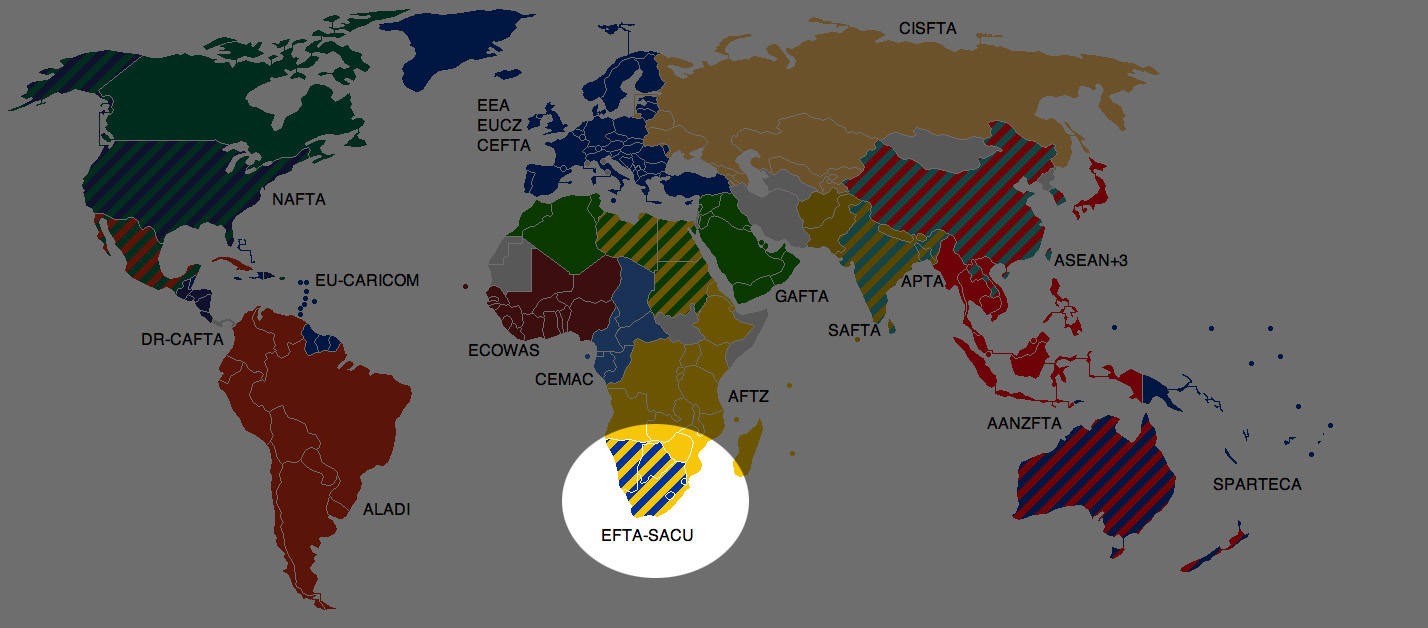Free trade agreements are typically established between countries that share various demographics in common - most notably proximity. Countries that enter into treaties with neighboring countries demonstrate their willingness to remove tariffs on goods that cross borders, and in turn the respective governments attempt to reconcile political and other differences through cooperative trade. When countries firmly established in one FTA work toward expanding the agreement to include other nations, the opportunity for improvement in economy increases.

The European Free Trade Association (EFTA), founded in 1960, consists of four small countries that nonetheless have proven important in various trade sectors, in particular banking and finance. Their association with the Southern African Customs Union (SACU) in a treaty finalized in 2008 signifies an agreement designed to benefit both regions as customs are eliminated on imports to Europe and Africa. SACU countries receive ample supplies of medicine and machinery to aid improvement in their industrial sectors, while the EFTA nations may import needed precious metals and natural resources more commonly found in Africa.
The EFTA is comprised of:
- Iceland - Iceland's small economy does exceed that of some SACU nations. Their somewhat isolated location in Northern Europe makes trade practically a necessity, and for their part Iceland exports fish and byproducts and select minerals.
- Liechtenstein - Liechtenstein's prosperous economy may stem from low taxes and ease of incorporation. The nation's primary exports include machinery, audio and video components, and electronics.
- Norway - Foreigners may associate Norway mainly with the fishing industry. While fish is a prime export, the country also trades out petroleum and machinery.
- Switzerland - The world is familiar with Swiss chocolate and precision Swiss watches and clocks, but this only scratches the surface of their main exports, which also include pharmaceuticals and electronics.
SACU is comprised of:
- Botswana - Botswana has enjoyed progressive economic growth in the last three decades, well before the EFTA-SACU agreement. Precious gems and metals - diamonds, coppers, and nickel - represent the bulk of the country's exports.
- Lesotho - Since finalization of the joint agreement, about one fifth of all the country's exports - textiles and diamonds - are sent to EFTA nations while the rest are exported to SACU partners and the United States.
- Namibia - Namibia is a nation rich in precious gems and metals, including diamonds, copper, gold and zinc. Despite these major exports, mining represents a very small fraction of overall employment.
- South Africa - Perhaps the largest economy among SACU nations, South Africa is the world's largest producer of platinum and gold.
- Swaziland - Mining plays an important role in this nation's economy, though resources have depleted over time. Swaziland relies mainly on wood and sugar to export.
Since coming to an agreement in 2008, the nations of EFTA and SACU have noted an increase in value of their respective trade merchandise. In 2010, nearly $3 billion worth of goods traded between member nations, and future endeavors hope for steady growth. Recent meetings between EFTA and outside nations, including India and Indonesia, may also bode well for SACU nations if there is an opportunity to expand on trade through their association with Europe.